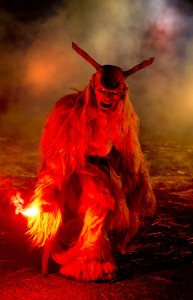Beware the Krampus!
December 6, 2016
Last night, December 5, was Saint Nicholas Eve. On this night, the kindly patron saint of children traditionally visits homes to leave gifts for well-behaved youths. But did you know that last night was also Krampusnacht (German for Krampus night)? Krampusnacht is a celebration of the lesser-known, darker companion of St. Nicholas named Krampus, whose purpose is to scare little ones into being good.

On St. Nicholas Eve, some people dress in elaborate, frightening Krampus costumes and participate in parades celebrating Krampusnacht (Krampus night). Credit: © Sergio Delle Vedove, Shutterstock
In Austrian Christmas folklore, Krampus is a beastlike figure modeled after the Christian Devil and northern European pagan gods. Krampus disciplines naughty children, often threatening them with physical punishment. Images of Krampus show him with large, goatlike horns, a long tongue, sharp teeth, and hooves. Some accounts describe him with an empty basket on his back—used for carrying away misbehaving kids! He is sometimes pictured carrying chains, and holding birch twigs or a whip for beating unfortunate little ones.
The Krampus legend originated in the Middle Ages, when St. Nicholas, a historic bishop from modern day Turkey, became a popular gift-giving figure. Medieval Christians created a companion for the saint to discipline naughty children and to serve as a sort of alter ego (other self or close associate) of Nicholas. This tradition was especially popular in central and eastern Europe. The Krampus companion has various names, including Knecht Ruprecht or Belsnickel in parts of Germany, Schmutzli in Switzerland, and Zwarte Piet in the Netherlands.
In the legends, St. Nicholas prevents Krampus from actually harming any children. Instead, Nicholas scolds the children and tells them to change their ways. Over time, the Krampus figure became less frightening. In the 1800’s in Austria, accounts described him as accompanying St. Nicholas through village streets and to children’s homes, suggesting that he was not really so dangerous. In modern times, Krampus has been the subject of novels, comics, television programs, video games, and at least one motion picture (Krampus, 2015). Playful holiday cards called Krampuskarten feature such greetings as Grüß Vom Krampus! (Greetings from Krampus) and images of Krampus disciplining children or wooing attractive young women.
Today, communities in Austria, southeastern Germany, northern Italy, and other parts of Europe celebrate the Krampus tradition on Krampusnacht or other days with parades, Krampuslaufe (Krampus runs), and other forms of “frightening” revelry. Participants dress up in elaborate, terrifying costumes complete with glowing eyes and fiery hands, impersonating Krampus to pay tribute to this popular “anti-Santa.” Such events have even spread to communities in the United States. Spectators can expect to hear intimidating growls rather than jolly Ho-ho-ho’s, and possibly even a swipe with a birchwood switch!


